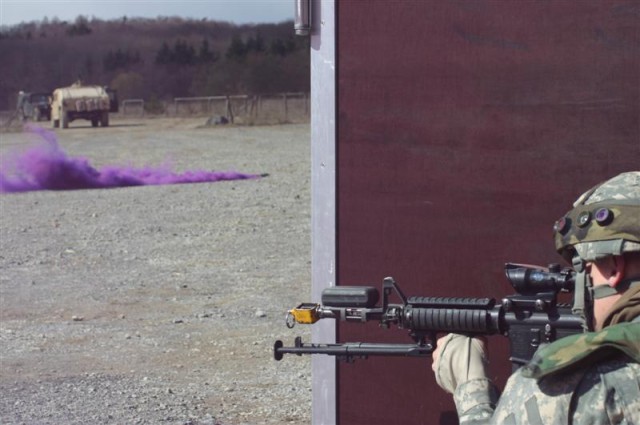SCHWEINFURT, Germany - The 1st Squadron, 91st Cavalry Regiment (Airborne) wrapped up a 10-day training exercise March 31, called Aca,!A"Operation Saber Charge,Aca,!A? that offered platoon leaders and their Soldiers the opportunity to train on a wide variety of tasks.
"It's an opportunity on the dry-fire ranges to get the new platoon leaders to move their platoons around with commander oversight" with outside observer-controller (OC) oversight, said Capt. Perry Morton, spokesman for the 1-91 CAV.
The missions included the live firing at Wildflecken ranges, and cordon-and-search, mounted patrols and dismounted key leader engagements, all at Camp Robertson training area.
"Having a training area out here like this, close to Ledward, close to the Bundeswehr, allows us to concentrate on the training, rather than the preparation," Morton said of the benefits to having such an expansive local training area.
Operation Saber Charge gave the small, platoon-sized units a chance to find their rhythm and define their standar operating procedures, according to 1st Lt. Jay Feldt, platoon leader for 1st Platoon, Blackhorse Troop.
"There are so many different scenarios. Right now, we're trying to get our baseline, trying to get the basics down. That way, we can form our team, our platoon," Feldt said.
"You can plan a perfect plan and have the most detailed thing, but as soon as you cross that wire, you have no idea what's going to happen. Anything can happen. You can't plan for everything. So we're trying to develop those thinking skills so they don't need their leaders to tell them exactly what they do," he said.
Feldt, his platoon sergeant, Sgt. 1st Class Steve Carbajal, and senior scout, Staff Sgt. Jeff Marschewski, are a brand new leadership and were using the exercise to develop their platoon standard operating procedures.
"This is the first time the three of us are working together," Carbajal said.
"It gives us an opportunity to see what we need to do to get the information to the lowest level," and allows them to develop plans constantly," Carbajal said.
The Soldiers used the exercise to draw on each others' knowledge and experiences, especially with such a highly combat-tested group of Soldiers, according to Marschewski.
"We've got a lot of different guys from a lot of different units. And when we all come together and come with different plans, we've got good knowledge around the platoon," he said.
During the cordon-and-search missions, while Soldiers were on the ground fighting house-to-house, Apache helicopter crews from the Ansbach-based 12th Combat Aviation Brigade flew in and provided over watch support.
"The 12th CAB to come out and support us, both attack and lift, and they came on board about two weeks ago and said they wanted to come out here and support this training," said Lt. Col. Paul Fellinger, squadron commander.
Fellinger, watching a cordon-and-search mission March 24, called his unit "one of the most versatile units in the United States Army. We can do it from a parachute. We can do it from a vehicle. We can walk in."
Feldt, likely sharing the sentiments of his fellow platoon leaders, was grateful for the chance to exercise their leadership within the confines of the larger, squadron-level mission.
"(Squadron leadership) also allowed us about three days or so to ourselves, so that we can specifically develop our own plans, down to the troop level, down to the section and team level. And that's what we really need," he said.
More photos from Operation Saber Charge are available at http://www.flickr.com/photos/schweinfurtpao


Social Sharing